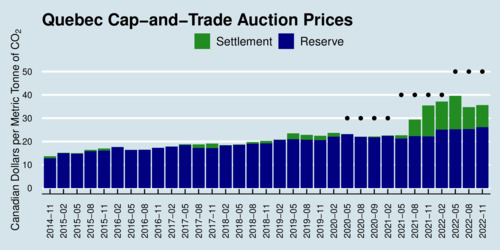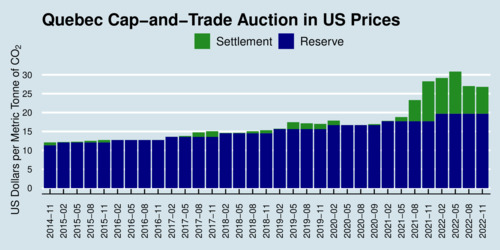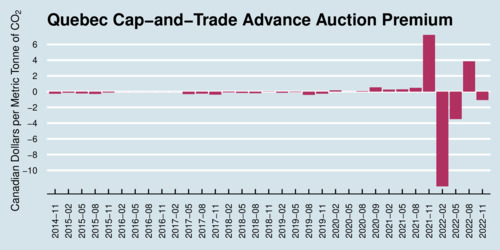Quebec's approach to pricing carbon emissions is unique in Canada. The province has joined California in an emission trading system, also known as as cap-and-trade system. I had previously written about this in May 2015 and in October 2016. Quebec's carbon price is not keeping up with the increases in the federal carbon price, which today stands at $50/tonne of carbon dioxide emissions and is scheduled to increase in $15/tonne steps annually until it reaches $170/tonne in 2030.
‘Quebec's latest carbon price of $35.62 makes it a climate laggard in Canada. Quebec needs to rethink its approach to carbon pricing.’
The diagram below shows the prices that emerged out of Quebec's emission trading system with California from its inception until today. Originally, Quebec was a climate leader by pricing carbon emissions before a federal system was put into operation in 2019. The bars show Quebec's carbon price, and the matching black dots show the federal carbon price, which since April 2020 has been higher than Quebec's cap-and-trade price. At the 33rd auction in November 2022, the settlement price of $35.62 made it only 71% of the federal carbon price. In other words, Quebec received a 29% discount on carbon prices. It is time for Quebec to rethink how it manages its carbon pricing, and not become a climate action laggard.

click on image for high-resolution PDF version
Quebec's participation in the joint auction program with California comes with several important features. First, prices are determined jointly and thus move at a speed of reductions in the carbon cap that each side feels comfortable with, and this can easily become the lowest common political denominator. While California is a climate leader in the United States, the US state has also initiated numerous parallel climate programs that compete with carbon pricing. It appears unlike that California will accelerate reducing its emissions cap, and thus carbon prices will not rise as fast as federal carbon prices.
Second, exchange rate changes have an impact on Quebec's carbon price. As the next diagram shows, in US dollar terms the prices move somewhat differently. The cap-and-trade system imports price volatility from the USD-CAD exchange rate.
Third, Quebec's cap-and-trade has never been a pure cap-and-trade system. In fact it is a hybrid system with a reserve (i.e., minimum) price. These are the blue bars in the diagram. The settlement price is where the auction clears. For a long time, the settlement price was barely above the reserve price. This only change in late 2021. What this means is that in earlier years the cap was not binding, and therefore the auction settled near the reserve price. While this has changed in 2021, the settlement price below the federal carbon price indicates that Quebec's carbon cap is not stringent enough to drive up prices to near the federal carbon price.

click on image for high-resolution PDF version
Fourth, the joint Quebec-California trading system allows trading in allowances for the next compliance period. This advance auction has typically had a price that was virtually the same as the auction price for the current compliance period. This started changing only in November 2021. Curiously, however, the advance auctions are not trading consistently at a premium, which is what you would expect if there is anticipation that the prices in the next compliance period (usually at least three years) will rise due to lower emission allocations. Perhaps this is a reflection of uncertainties about the state of the economy, as a recession is a distinct possibility. Nevertheless, if the markets anticipated Quebec to see increases in the auction prices similar to the increases in the federal carbon price, the premium should be well over $15/tonne for the 2025 auction vintage.

click on image for high-resolution PDF version
In 2021, Quebec's cap was 55.26 megatonnes of carbon dioxide (equivalent). The province is anticipating decreasing this by 1.235 megatonnes per year to reach 44.14 megatonnes in 2030 (source). According to an information sheet from the government of Quebec, they expect the reserve price to increase from US$17.71 in 2021 to US$32.57 in 2030—which puts it just under CAD 45 per tonne. rather than the federal $170/tonne.
So what are the options for Quebec to move forward and prevent becoming a climate action laggard? Essentially, there are three scenarios.
‘Decoupling its cap-and-trade system from California is Quebec's easiest route to embracing climate leadership again.’
The first option is to detach the trading system from California. Decoupling its cap-and-trade system from California is Quebec's easiest route to embracing climate leadership again. It would allow Quebec to pursue more stringent reductions in the emissions cap, or alternatively set reserve prices for the auction that are close to the federal carbon price. The downside is that it will take time to unwind because the trading for the next compliance period (2022-2025) is already under way. So the logical starting point for a new Quebec carbon pricing system would be 2026. Meanwhile, is the federal government of Canada prepared to accept that Quebec will benefit from an carbon discount? Other provinces will be loud to complain about political favoritism towards Quebec.
Decoupling Quebec's emission trading system from California does not pose any insurmountable difficulties. The original aim of joining another jurisdiction was to provide efficiency and liquidity. In an ideal world, such trading would be beneficial because emission reductions would occur where they are easier, that is, cheaper. If emission reductions are more expensive in Quebec than in California, then Quebecois companies could buy permits from Californian companies. However, as Canadian carbon prices are meant to rise faster than is currently anticipated in California, Quebec would need to lower its own emissions cap dramatically to drive up prices in the joint market to match the federal targets, but that is unlikely to be agreeable to California. A clean separation is the only way forward, unless Quebec prefers one of the next two options.
The second option is to scrap the cap-and-trade system altogether and either join the federal program or adopt a system similar to British Columbia. Politically, the latter option may be slightly more agreeable to an independent-minded Quebec government. It would give the Quebec government more degrees of freedom to develop the system on its own terms. Nevertheless, the federal carbon pricing is designed carefully and ensures that (1) households receive quarterly rebates (known as climate action incentive payments) that offset the income-regressivity of the carbon tax, and (2) emission-intensive trade-exposed industries are protected against adverse competitive outcomes through the output-based pricing system.
The third option is the least desirable politically, both for Ottawa and Quebec City. It would involve a political battle where the federal government would assert its authority under the Greenhouse Gas Pollution Pricing Act (GGPPA), which has been upheld by the Supreme Court of Canada. Such battles quickly turn ugly and ultimately leave both sides worse off. It would be better for both sides to find a reasonable compromise to bridge the gap until Quebec can catch up to the federal standards. However, there can be no "free pass" for Quebec, or the GGPPA will be hollowed out. If Quebec's premier François Legault and his Coalition Avenir Québec are not willing to close the carbon pricing gap, Ottawa will have no choice but to exercise its federal jurisdiction in the matter. Provincial revenue from the federal carbon price stays in each province. So whatever Ottawa may need to impose on Quebec, the revenue would stay in Quebec and would be returned to Quebec households. It would be much better for all sides if Quebec saw the wisdom in yet again aiming for climate leadership.
Overall, Quebec's GHG emissions of 76.2 megatonnes of carbon dioxide (equivalent) in 2020 gave the province the lowest per-capita emission intensity (8.9 tonnes per person, roughly half of the federal 17.7 tonnes per person). This is mostly due to Quebec's abundant hydroelectricity. This means that roughly two-fifth of emissions come from transportation, and roughly one-quarter from industries. Because transportation has an outsized share, driving up carbon prices (and thus fuel prices) is necessary to shift motorists from gasoline-powered vehicles into electric vehicles, along the way reducing emissions from refineries. Quebec has significant potential to accelerate its transition to increased electrification of mobility. Higher carbon prices will accelerate this transition.
Criticism of the carbon price differential comes from different corners. Some are merely trying to score political points, especially when the criticism comes from political corners that reject carbon pricing in the first place. Yet, the carbon pricing gap is real and will widen if not addressed. Under authority of the GGPPA, Ottawa must initiate talks with Quebec to rectify the carbon pricing gap, and Quebec needs to do its bit to find a workable solution.
- Gary Mason: It's time Quebec started paying as much carbon tax as the rest of Canada, The Globe and Mail, December 9, 2022.
- Robert Lyman: Opinion: The unfairnesses in carbon pricing, Financial Post, August 3, 2022.
- Charles Lecavalier: Québec met la barre bien moins haut qu'Ottawa, La Presse, 28 April 2022.
- Quebec Ministère de l'Environnement, de la Lutte contre les changements climatiques, de la Faune et des Parc: Cap-and-Trade Auction Notices and Results
- Government of Canada: Update to the Pan-Canadian Approach to Carbon Pollution Pricing 2023-2030.
![[Sauder School of Business]](logo-ubc-sauder-2016.png)
![[The University of British Columbia]](logo-ubc-2016.png)